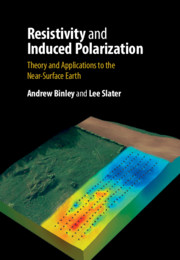Book contents
- Resistivity and Induced Polarization
- Reviews
- Resistivity and Induced Polarization
- Copyright page
- Contents
- Preface
- Acknowledgements
- Symbols
- 1 Introduction
- 2 Electrical Properties of the Near-Surface Earth
- 3 Instrumentation and Laboratory Measurements
- 4 Field-Scale Data Acquisition
- 5 Forward and Inverse Modelling
- 6 Case Studies
- 7 Future Developments
- Appendix A Modelling Tools
- References
- Index
- Plate Section (PDF Only)
4 - Field-Scale Data Acquisition
Published online by Cambridge University Press: 17 December 2020
- Resistivity and Induced Polarization
- Reviews
- Resistivity and Induced Polarization
- Copyright page
- Contents
- Preface
- Acknowledgements
- Symbols
- 1 Introduction
- 2 Electrical Properties of the Near-Surface Earth
- 3 Instrumentation and Laboratory Measurements
- 4 Field-Scale Data Acquisition
- 5 Forward and Inverse Modelling
- 6 Case Studies
- 7 Future Developments
- Appendix A Modelling Tools
- References
- Index
- Plate Section (PDF Only)
Summary
In this chapter, we explore the range of electrode configurations for measurement of resistivity and induced polarization (IP). We introduce the concept of apparent resistivity and chargeability and illustrate, for relatively simple cases, how the apparent resistivity is affected by non-uniformity of resistivity (e.g. a layered subsurface). We introduce the graphical presentation of apparent resistivity and IP measurements in a pseudosection for 2D problems. We discuss some of the practical aspects of field measurements, including choice of electrode configuration and assessment of measurement errors.Although we provide extensive coverage of the more standard ground-based electrical methods which account for a vast proportion of electrical surveying, we illustrate how measurements can be made in ‘non-standard’ settings, such as between boreholes or for imaging laboratory-scale tanks and columns, and also discuss time-lapse measurement approaches. We also illustrate how potential fields using the same four electrode configuration allows the mapping of electrical current, which has applications in the detection of fluid leaks, e.g. in landfills.
- Type
- Chapter
- Information
- Resistivity and Induced PolarizationTheory and Applications to the Near-Surface Earth, pp. 154 - 212Publisher: Cambridge University PressPrint publication year: 2020

